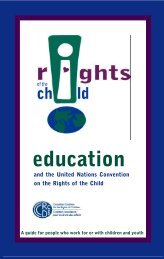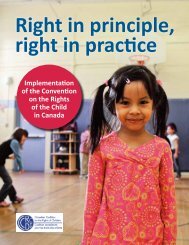Poste - Canadian Coalition for the Rights of Children
Poste - Canadian Coalition for the Rights of Children
Poste - Canadian Coalition for the Rights of Children
Create successful ePaper yourself
Turn your PDF publications into a flip-book with our unique Google optimized e-Paper software.
Voices<br />
<strong>of</strong> Parents<br />
Alberta pays <strong>for</strong> leg braces only once a year,<br />
but my six-year-old needs new ones every six<br />
months (at a cost <strong>of</strong> about $2,000 a pair). He<br />
also requires inserts <strong>for</strong> his shoes, at about<br />
$400 per pair and that’s not covered ei<strong>the</strong>r. 162<br />
The health plan covers only $300 <strong>of</strong> a $1200<br />
hearing aid and that’s only part <strong>of</strong> <strong>the</strong> hearing<br />
system. 163<br />
My child’s special enemas cost $80.00 per<br />
month and that’s not covered. 164<br />
All provinces have case management systems to integrate<br />
community-based health care services <strong>for</strong> a child with a<br />
disability or chronic illness but a lack <strong>of</strong> coordination by<br />
government departments can lead to gaps in services.<br />
Yukon has no case management system at all and <strong>the</strong><br />
Northwest Territories was still developing one <strong>for</strong> preschool<br />
children in 1997 (and already had it in place <strong>for</strong> schoolaged<br />
children). 165 Manitoba pediatrian Brian Postl argues<br />
that case management systems need to unify referral and<br />
intake systems. 166 Researchers Hayes, Hollander et al.<br />
recommend research to increase effectiveness and<br />
efficiency <strong>of</strong> service delivery <strong>for</strong> children, especially those<br />
with disabilities. 167<br />
The <strong>Canadian</strong> Pediatric Society strongly supports <strong>the</strong> right<br />
<strong>of</strong> every child to receive necessary medical care to improve<br />
or prolong life. 168<br />
Usually <strong>the</strong> best interests <strong>of</strong> <strong>the</strong> child will favour<br />
<strong>the</strong> provision <strong>of</strong> life-sustaining treatment. This is<br />
self-evident where <strong>the</strong> result <strong>of</strong> <strong>the</strong> treatment will<br />
be <strong>the</strong> survival <strong>of</strong> a child with no or little<br />
handicap, but should be equally true even when a<br />
chronic physical or mental handicap continues to<br />
be present. 169<br />
Case Law<br />
H O W D O E S C A N A D A M E A S U R E U P ?<br />
69<br />
Health care commentator André Blanchet says that in<br />
practice, medical treatment <strong>for</strong> people with disabilities<br />
does not meet legislative or policy goals <strong>for</strong> equal health<br />
care provision, citing “conscious or unconscious value<br />
judgments made by pr<strong>of</strong>essionals about quality <strong>of</strong> life <strong>of</strong><br />
people with a disability.” These judgments are rein<strong>for</strong>ced<br />
by concerns about <strong>the</strong> costs <strong>of</strong> treating and maintaining<br />
<strong>the</strong> lives <strong>of</strong> children with severe disabilities. 171<br />
In 1995, an Alberta hospital denied a request to add a<br />
17-year-old boy with Down syndrome to <strong>the</strong> waiting list<br />
<strong>for</strong> a lung transplant. 172 However, this decision was<br />
overturned after media attention, a letter-writing<br />
campaign and public demonstrations led <strong>the</strong> hospital to<br />
draft a policy to support needed transplants <strong>for</strong> people<br />
with intellectual disabilities. 173<br />
Due to <strong>the</strong> many obstacles to health care <strong>for</strong> Aboriginal<br />
children (jurisdictional conflicts, lack <strong>of</strong> services, remote<br />
communities, etc.) 174 <strong>the</strong> Royal Commission on<br />
Aboriginal Peoples recommended long-term structural<br />
changes to <strong>the</strong> <strong>Canadian</strong> health care system and<br />
improvements in prevention, treatment and<br />
rehabilitation. 175 The Commission also noted that some<br />
federal services and programs are available to registered<br />
Indians and Inuit but not o<strong>the</strong>r Aboriginal peoples. 176 Its<br />
recommendations included:<br />
• reorganization <strong>of</strong> existing health and social services<br />
under Aboriginal control;<br />
• adaptation <strong>of</strong> mainstream services to better meet <strong>the</strong><br />
needs <strong>of</strong> Aboriginal people and encourage <strong>the</strong>ir full<br />
participation in decision making; and<br />
• meaningful ef<strong>for</strong>ts <strong>for</strong> cultural sensitivity and<br />
responsiveness to <strong>the</strong> needs <strong>of</strong> Aboriginal people. 177<br />
Technology and Disability<br />
Technology can improve <strong>the</strong> quality <strong>of</strong> life and<br />
integration <strong>of</strong> persons with disabilities in society with<br />
useful assistive devices, improved communications and<br />
medical advances. Some <strong>Canadian</strong> jurisdictions provide<br />
funding to improve access to assistive devices. However,<br />
<strong>the</strong>re is concern that genetic research leads to questions<br />
In Eldridge v. British Columbia (Attorney General), 170 <strong>the</strong> Supreme Court <strong>of</strong> Canada ruled that hospitals, as providers <strong>of</strong><br />
government-sanctioned medically necessary services, have a constitutional duty under Charter s. 15 to provide equal<br />
access to all government services. Hospitals are now required to provide sign language interpreters <strong>for</strong> <strong>the</strong>ir patients<br />
who are hearing impaired.




